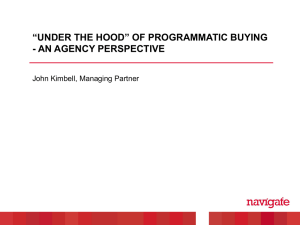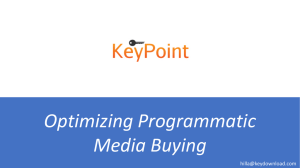The Promise of Programmatic TV
advertisement
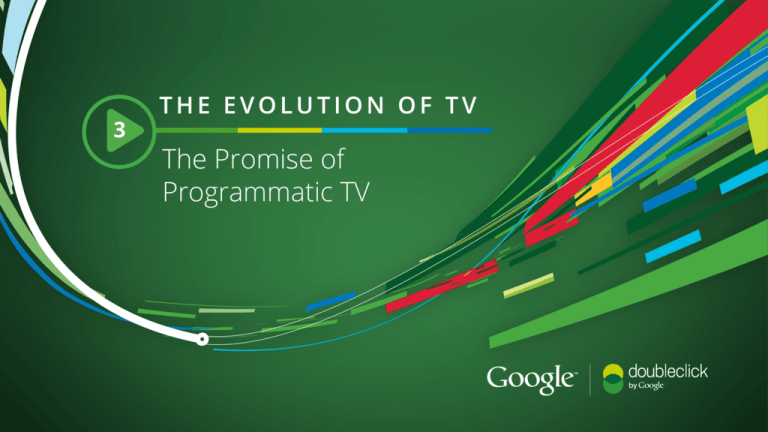
3 THE EVOLUTION OF TV The Promise of Programmatic TV Our Evolution of TV series explores how TV is shifting to internet delivery. Programmatic TV is one dynamic driving the shift and potentially transforming the way TV is bought and sold. Here we dispel the hype and discuss the positive impact for brands, programmers, and distributors. Rany Ng, Director of Product Management, Video Anish Kattukaran, Product Marketing, Video & Brand Measurement thinkwithgoogle.com 2 The future of TV advertising U.S. TV advertising revenue Television advertising is big business. How big? TV ad spending in the U.S. is projected to reach that time of year when traditional TV networks and, increasingly, digital media companies gather to present their fall lineups and pitch marketers for ad dollars. Whatever TV inventory hasn’t been sold, While this traditional TV buying and selling model has worked for decades, it’s not without its inefficiencies. Chief among them is the fact that many of the interactions that occur are manual: requests for proposals, insertion orders, and ad trafficking, not to mention the endless emails, spreadsheets, and even faxes. So it’s no surprise that, as in other areas of advertising, there’s a lot of chatter in the TV industry about whether a digital approach might be more efficient. Programmatic TV is just such a solution, and one that could apply digital advertising’s efficiency models to TV advertising. Revenue in billion U.S. dollars or is held back, is then sold in what is called the scatter market. $69 $71.9 $78 $80.1 $83.6 © Statista 2015 almost $84 billion per year by 2018. Traditionally, many of these billions are spent during upfronts— We define programmatic TV as a technology-automated and data-driven method of buying and delivering ads against TV 2014 2015 2016 2017 2018 content. This includes digital TV ads served across the web, mobile devices, and connected TVs, as well as linear TV ads served across set-top boxes. thinkwithgoogle.com 3 As with any new technology, though, there are skeptics, and the “why change what’s not broken?” mentality has its adherents. We’re here to say that, while the TV buying and selling process isn’t exactly broken, it could be better, simpler, and faster with programmatic TV. The programmatic TV skeptics, understandably, are focused on its present capabilities, which are lacking. Today, the programmatic TV solutions presented to programmers (the owners of one or more television channels), distributors (service providers that deliver television channels), and brand advertisers are more sizzle than substance. With the majority of these solutions, audience targeting and digital automation of the linear TV workflow hasn’t caught up to the level of sophistication that’s prevalent in programmatic buying across digital video. However, programmatic TV has the potential to be a win for audiences, advertisers, and the television industry itself. It’s an exciting prospect. Imagine when programmatic TV is a reality—when buying and selling is instantaneous and data-driven. Programmers and distributors will be able to monetize their TV ad inventory properly regardless of screen size, including niche programming and content on connected devices (a pain point for most of them today). Brand advertisers will be able to get even more specific with their targeting, and viewers won’t be inundated with repetitive, irrelevant ads. In part one of our in-depth Evolution of TV series, we discussed the complexities and opportunities associated with the 7 Dynamics Transforming TV. Part two explored the first of those dynamics: delivering content to a fragmented audience. Here we delve into another of those dynamics, programmatic. We dispel the rumors and concentrate on the promise (and yes, the challenges) for programmers, broadcasters, and advertisers. thinkwithgoogle.com 4 The potential of programmatic TV for brand advertisers There’s a long list of reasons why programmatic TV makes sense for advertisers. At the most basic level, advertisers have business and marketing objectives to achieve. What could be better than a single advertising system that automates planning, buying, and measurement across channels, screens, and formats? This is the promise of programmatic. At a more detailed level, it gets even better. Take a look: thinkwithgoogle.com 5 The potential of programmatic TV for brand advertisers Automated buying: Data-driven targeting: Cross-screen measurement: Unified campaign management: Real-time optimization: Traditionally, the workflow for TV ad Data is one of the fundamental For brand advertisers, the ability to Given that 77% of TV viewers now With programmatic TV, we could get buying has gone something like this: components of programmatic, and measure the effectiveness of campaigns watch TV with a laptop, phone, or tablet faster performance metrics during Buyers plan in a siloed system dedicated this is as true for TV as it is for digital. holistically across all channels, close at hand, it’s no wonder viewer a campaign’s flight instead of days, to TV advertising, insertion orders The promise of programmatic TV, as it including TV, could be a reality in the attention is divided. A unified buying weeks, or months after a campaign are shuttled back and forth manually pertains to data, is to achieve parity with not-so-distant future. The KPI for platform gives brand advertisers a single is completed. Automated algorithms between buyer and seller, and reports and then move beyond the age, gender, TV optimization might be a unified and seamless platform from which to could use this feedback to help improve are generated upon completion of a reach, and frequency components of and improved GRP across TV and plan, buy, measure, and manage all of campaign performance in real time or campaign when it’s too late to do any targeting based on gross rating points digital, or any other metric such as their advertising campaigns holistically, near real time. optimization. With programmatic TV, (GRPs). Not only do first-, second-, viewable impressions, video completes, whether target audiences are viewing planning, execution, and measurement and third-party data sets segment conversions, brand lift, or sales lift. ads from set-top boxes to smartphones. can happen in conjunction with display audiences more precisely, they also help for a holistic view of all advertising, which advertisers and programmers fine-tune is focused on business objectives and the delivery of more personalized, the target audience. Automated buying relevant content to users, even as users will help speed up processes while switch between screens. cutting down on manual ones. thinkwithgoogle.com 6 Programmatic TV: Setting the record straight It’s unlikely that programmatic TV will start out in the same manner as it did in the digital display ad world. That means no real-time bidding on open exchanges right off the bat. TV inventory is scarce and premium, so programmers and distributors are going to want a high level of control over transactions. As a result, we’re likely to see a mix of programmatic reservations, preferred deals, and private exchange deals. These will be coupled with premium TV and video marketplaces (such as Google Partner Select), which will emerge to help TV ad buyers and sellers transact. Chief among programmers’ and broadcasters’ concerns about programmatic TV is that it will lower the value of their TV inventory. Let’s quash that thinking right now. Here’s why programmatic makes sense for TV programmers and broadcasters: thinkwithgoogle.com 7 Programmatic TV: Setting the record straight Advertiser demand: Supply is low and demand is high for TV inventory. Inventory prices: Currently, some in the TV industry believe that moving Adoption of programmatic TV will not change the economics of supply to a programmatic environment means “a race to the bottom” because they and demand. Quality TV ad spots that reach the right TV viewers will still associate programmatic with open auctions and no price floors. While this command good rates, even when transactions are streamlined within a may have been the case in the early days of programmatic for display banner programmatic workflow. ads, it’s not the reality of programmatic today, particularly for TV and video. Programmatic’s promise—data-driven targeting, automated workflows, cross-screen campaigns, and real-time optimization—will help advertisers get Addressable inventory: Niche linear and cross-screen TV inventory is more value from TV advertising. As the value goes up, so too will the prices often undervalued and undersold, because it’s hard for advertisers to buyers are willing to pay for media. buy this valuable inventory. With pod- and impression-level bidding and enhanced audience targeting across linear and digital TV, programmatic could create a simplified and more efficient marketplace for this Risk: Programmers and broadcasters will be able to use sophisticated tools inventory. The result will be increased budgets and yield of TV inventory to set business rules around their premium content, thereby protecting its for programmers and broadcasters. This is a reality today with digital TV value. With rules in place, programmatic TV can streamline ad operations, ad inventory using technologies such as dynamic ad insertion. serving, and the ad experience across devices. Waste: Programmatic TV could empower programmers and distributors to Fragmentation: Today’s advertisers are plagued with separate technology sell impressions rather than shows. The industry is accustomed to selling solutions to manage different aspects of advertising across channels, a show based on GRPs. But that means any impression that doesn’t fit the audiences, and data sets. A single programmatic buying platform would target audience is monetized at a discount, resulting in waste for the seller. provide a unified solution for all of their ad buying. For programmers Selling based on audiences, instead of points, would eliminate discounts and and distributors, using an integrated ad sales stack can ensure that waste. direct-sold internet TV ads are delivered on schedule, while awarding ad slots to programmatic transactions where it can improve yield. It can also power dynamic ad insertion, so each viewer sees only relevant ads, and help fill unsold inventory, thereby improving monetization. In the near future, programmers and distributors will be able to sell their linear TV ad inventories alongside their digital inventories. thinkwithgoogle.com 8 PHASE 1 (Now) Challenges to implementation While programmatic TV offers a lot of promise, it’s still quite new. And given that we’re still in the very early stages, it’s no surprise that many of the solutions currently billed as programmatic TV are not living up to the technology’s potential. Moving the industry toward mass adoption of programmatic Buyers and sellers using programmatic technology to transact premium digital video buys 4x will likely happen in phases. First, buyers and sellers will use programmatic technology to transact premium digital video buys. This phase is actually underway and making strides. In fact, in 2014 there was a 4X growth in impressions for videos transacted programmatically, according to Google data. Next, as the programmatic infrastructure matures, it will become easier and more efficient for buyers and sellers to place ads in streaming and video-on-demand TV content across connected devices. The last piece of the puzzle, and arguably the most complex, is the support for linear TV, which will take some significant work because it calls for integrating digital platforms with traditional systems and data vendors across the TV ecosystem. Fulfilling the promise of programmatic TV and achieving widespread adoption means overcoming several ideological and technical challenges. We need to get programmers, broadcasters, and advertisers to understand what programmatic TV can do instead of what they think it does. Then we can focus on the things that really matter such as universal measurement across all advertising platforms, the ability to reach viewers across screens, access to inventory devoid of rights issues, and growth in impressions for videos transacted programatically PHASE 2 Buyers and sellers will be able to place ads in streaming and video-on-demand TV content across connected devices NOW PHASE 3 FUTURE Support for linear TV will happen with better integration of digital platforms legacy systems and data vendors across the TV ecosystem programmatic buying support for set-top boxes. As brand advertisers, programmers, distributors, and ad tech providers work through these challenges, programmatic TV will begin to live up to its potential. It’s an exciting prospect given the predictions for the industry. According to eMarketer, “Though it now accounts for less than 1% of all TV ad spending, some predict programmatic TV could be a multi-billion dollar industry in 12 to 24 months.” thinkwithgoogle.com 9 The evolution of TV advertising The technology that programmers, broadcasters, and brand advertisers choose for transacting TV ads in live, on-demand, and (eventually) traditional linear TV will have a lasting impact on the evolution of TV. If programmatic TV does indeed realize its full potential, viewers will be seeing ads that are more relevant than ever, brand advertisers will benefit from higher returns on investments, and programmers and distributors will maximize yields. The next few years will be an exciting time as we watch the growth and innovation in programmatic buying and selling of TV ads. Viewer engagement Next up in our Evolution of TV series: TV’s migration to the cloud Addressable advertising Programmatic ad technology Measurement TV distribution and the cloud Reach across screens Internet TV streaming thinkwithgoogle.com 10 Google’s video solutions for Programmers, Distributors, and Publishers for Advertisers and Agencies Ad server: Digital marketing platform: doubleclick digital marketing Ad creative: Supply side platform: Demand side platform: Ad network: AdSense Ad server: Mobile apps monetization: Ad exchange: Ad exchange: Ad network: Premium programmatic video marketplace: Premium programmatic video marketplace: Content distribution partner: Media partner: Ads thinkwithgoogle.com 11

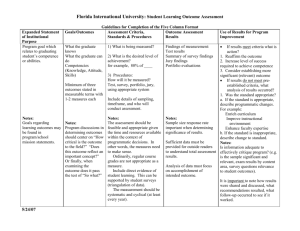
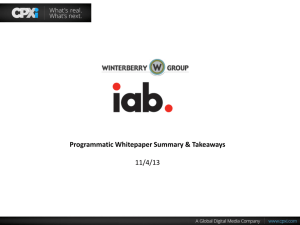
![612:3-5-29. Program Standards [AMENDED]](http://s3.studylib.net/store/data/007495491_1-6b02ab1f993713111546a2a9b18b2949-300x300.png)

